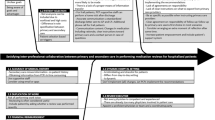Abstract
Background Interprofessional collaboration between pharmacists and physicians to conduct joint home medication reviews (HMR) is important for optimizing the medical treatment of patients suffering from chronic illnesses. However, collaboration has proved difficult to achieve. The HMR programme “Medisam” was launched in 2009 at the University of Copenhagen with the aim of “developing, implementing and evaluating a collaboration model for HMRs and medicine reconciliations in Denmark”. The Medisam programme involves patients, pharmacy internship students, the (pharmacist) supervisor of the pharmacy students and physicians. Objective To explore if it was possible through the Medisam programme to obtain a fruitful HMR collaboration between pharmacy internship students and physicians as a means to develop HMR collaboration between trained pharmacists and physicians further. Setting Ten matching pairs of student–physician collaboration were studied across Denmark. Method Semi-structured interviews about existing collaboration were conducted with pharmacy internship students in the HMR programme, their supervisors and physicians partners. The theoretical framework forming the analyses was derived especially from works of Bradley et al. (Res Soc Adm Pharm 8:36–46, 2012), and Snyder et al. (Res Soc Adm Pharm 6:307–23, 2010) on pharmacists/physician collaboration. Main outcome measure The development of inter-professional collaboration between students and physicians according to the three collaboration drivers: trustworthiness, role specification and professional interaction. Results Full collaboration was not achieved. Physicians found collaboration satisfactory, students however expressed the need of more interaction with physicians. The written collaboration contracts did not ensure a possible need of students to re-negotiate roles and tasks, and did therefore not entirely ensure role specification. Developing mutual professional interdependence through students being recognized by physicians to contribute to improved patient outcomes was also limited. Conclusion Some challenges to fruitful collaboration were identified. Solutions to these challenges include students and their pharmacist supervisors to find ways to present their collaborative needs to physicians and for students to illustrate more explicitly the benefits patient achieve if physicians implement the recommendations of students.
Similar content being viewed by others
References
Krass I, Taylor SJ, Armour CL. Impact of medication use and adherence of Australian pharmacists’ diabetes care services. J Am Pharm Assoc. 2005;45:33–40.
Krass I, Smith C. Impact of medication regimen reviews peformed by community pharmacists for ambulatory patients through liaison with general practitioners. Int J Pharm Pract. 2008;8:111–20.
Sorensen L, Stokes JA, Purdie DM, Woodward M, Elliott R, Roberts MS. Medication reviews in the community: results of a randomized, controlled effectiveness trial. Br J Clin Pharmacol. 2004;58(6):648–64.
Zermansky AG, Petty DR, Raynor DK, Freemantle N, Vail A, Lowe CJ. Randomised controlled trial of clinical medication review by a pharmacist of elderly patients receiving repeat prescriptions in general practice. BMJ. 2001;323:1–5.
Howard M, Trim K, Woodward C, Dolovich L, Sellors C, Kaczorowski J. Collaboration between community pharmacists and family physicians: lessons learned from the Seniors Medication Assessment Research Trial. J Am Pharm Assoc. 2003;43(5):566–72.
Pojskic N, MacKeigan LD, Book H, Ellison P, Breslin C. Ontario family physician readiness to collaborate with community pharmacists on drug therapy management. Res Soc Adm Pharm. 2011;7:39–50.
Snyder ME, Zillich AJ, Primack BA, Rice KR, Somma McGiney MA, Pringle JL, et al. Exploring successful community pharmacist–physician collaborative working relationships using mixed methods. Res Soc Adm Pharm. 2010;6(4):307–23.
Muijrers PEM, Knottnerus JA, Sijbrandij J, Janknegt R, Grol RP. Changing relationships: attitudes and opinions of general practitioners and pharmacists regarding the role of the community pharmacist. Pharm World Sci. 2003;25(5):234–41.
McGrath SH, Snyder ME, Duenas GG, Pringle JL, Smith RB, McGivney MS. Physician perceptions of pharmacist-provided medication therapy management: qualitative analysis. J Am Pharm Assoc. 2003;50(1):67–71.
Doucette WR, Nevins J, McDonough RP. Drivers affecting collaborative care between pharmacists and physicians. Res Soc Adm Pharm. 2005;1(4):565–78.
Halvorsen KH. Drug prescribing quality for older patients. Explicit indicators and multidisciplinary medication reviews (dissertation). Bergen: University of Bergen; 2012. p. 68.
Sørensen EW, Haugbølle LS. Using an action research process in pharmacy practice research—a coorporative programme between university and internship pharmacies. Res Soc Adm Pharm. 2008;4:384–401.
McDonough RP, Doucette WR. Developing collaborative working relationships between pharmacists and physicians. J Am Pharm Assoc. 2001;41(5):682–92.
Zillich AJ, McDonough RP, Carter BL, Doucette WR. Influential characteristics of physician/pharmacist collaborative relationships. Ann Pharmacother. 2004;38:764–70.
Bradley F, Ashcroft DM, Noyce PR. Intergration and differentiation: a conceptual model of general practitioner and community pharmacist collaboration. Res Soc Adm Pharm. 2012;8:36–46.
Wüstman AF, Haase-Strey C, Kuniak T, Ritter CA. Cooperation between community pharmacies and general practitioners in eastern Germany: attitudes and needs. Int J Clin Pharm. 2013;35:584–92.
Cooper RJ, Bissell P, Wingfield J. Islands and ‘doctors’ tools; the ethical significance of isolation and subordination in UK community pharmacy. Health. 2009;13(3):297–316.
Kaae S, Sørensen EW, Haugbølle LS. Exploring communication around medication review in community pharmacy. Int J Clin Pharm. 2011;33:529–36.
Freeman CR, Cottrell WN, Kyle G, Williams ID, Nissen L. An evaluation of medication review reports across different settings. Int J Clin Pharm. 2013;35:5–13.
Funding
This programme was supported financially by The Danish Ministry of Health.
Conflicts of interest
None.
Author information
Authors and Affiliations
Corresponding author
Rights and permissions
About this article
Cite this article
Kaae, S., Sørensen, E.W. & Nørgaard, L.S. Evaluation of a Danish pharmacist student–physician medication review collaboration model. Int J Clin Pharm 36, 615–622 (2014). https://doi.org/10.1007/s11096-014-9945-6
Received:
Accepted:
Published:
Issue Date:
DOI: https://doi.org/10.1007/s11096-014-9945-6



